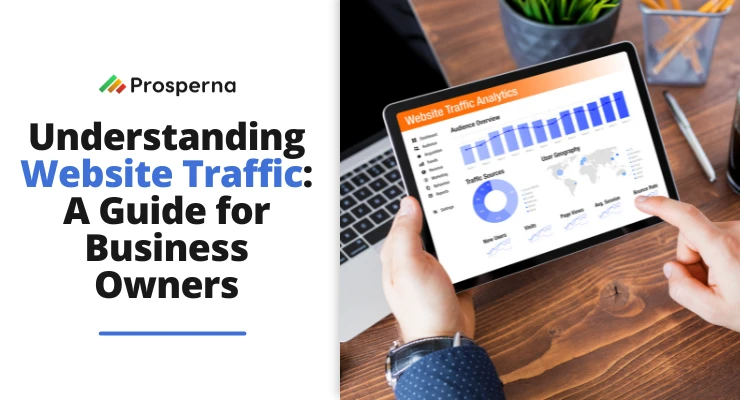In today’s digital age, having a website is essential for any business looking to succeed online. However, simply having a website isn’t enough to guarantee success. To truly optimize your online presence, it’s important to understand how your website is performing, who is visiting it, and why.
This is where website traffic comes into play. Understanding website traffic is crucial for improving the user experience, achieving your business goals, and ultimately driving revenue.
In this blog post, we’ll delve into what website traffic is, including the different types, key metrics to track, tools for measurement, and the numerous benefits of understanding it.
What is Website Traffic?
Website traffic refers to the number of people who visit a website and the interactions they have while on the site.
It is a measure of the popularity and performance of a website and is often used by business owners to track the success of their online presence.
Website traffic can come from a variety of sources, including search engines, social media, email marketing, online advertising, and direct visits.
Understanding where your website traffic is coming from can help you optimize your marketing plan and target your audience more effectively.
Types of Website Traffic
1. Direct Traffic
Direct traffic refers to website visitors who arrive at your website by typing your website URL directly into their browser or by clicking on a bookmarked link.
These visitors bypassed search engines, social media, and other external sources and went directly to your online store.
Direct traffic can be an important source of website traffic, especially if your business is well-known. However, it can also be difficult to track the specific source since it includes a variety of sources like mobile apps, emails, and instant messaging platforms.
As such, it’s important to analyze direct traffic data alongside other metrics to get a more complete picture of website performance.
2. Organic Traffic
Website visitors that find a site through unpaid, natural search engine results are referred to as organic traffic.
These visitors find the website by typing relevant search terms or phrases into a search engine like Google and then clicking on one of the search results that appear.
Organic traffic is an important source of website traffic for your online business, as it can provide highly qualified leads who are actively searching for the products, services, or information offered by your company.
Focus on these SEO strategies to attract organic traffic:
- Create engaging social media posts and high-quality content
- Use relevant keywords and meta descriptions
- Earn backlinks from other reputable websites
3. Referral Traffic
Referral traffic comes from external sources and is driven by links or mentions of a website on other websites or platforms.
The links could come from blogs or news articles, mentions on social media platforms, or email campaigns.
By tracking referral traffic data, you can gain insights into which external sources are driving the most traffic to your online store and adjust your marketing strategies accordingly.
Here are some ways to increase referral traffic:
- Guest posting on other blogs
- Sharing content on social media
- Collaborating with other businesses in your niche
4. Paid Traffic
Paid traffic includes display ads, search engine advertising (e.g., Google Ads), social media advertising, and other forms of online advertising.
It can offer practically immediate results, which can be very beneficial if you’re trying to quickly enhance your online visibility.
Paid traffic can be an effective way to increase traffic to your online store, but it can also be expensive and require careful management.
That’s why it’s important to track and analyze the performance of your paid advertising campaigns regularly to ensure that they are delivering the desired results.
Important Metrics to Track Website Traffic
Sessions
Sessions refer to the number of times users visit a website during a specified period, which could be a day, week, or month. It starts when a user visits a website and ends when they leave or are inactive for a specified amount of time—usually 30 minutes.
Sessions can provide insights into how users engage with a website.
For example, if a website has a high number of sessions, it may indicate that the website is generating a lot of traffic or that users are returning to the website frequently.
Page Views
This metric essentially does what it says. It provides you with the total number of times users have viewed a particular page on your website.
A high number of page views may indicate that users find the content on a particular page valuable, while a low number of page views may suggest that the content is not resonating with users.
Unique Visitors
A unique visitor refers to an individual user who visits a website within a specified period, usually 24 hours.
This metric provides insights into the total number of distinct individuals who visit your website, rather than the total number of visits or page views. You can use this to learn about your reach and overall audience.
Unique visitors are tracked using cookies, which are small files that are stored on a user’s device and used to identify them on subsequent visits to the website.
Bounce Rate
Your bounce rate is the percentage of website visitors who navigate away from your website after viewing only one page without interacting with any other content on your site.
A high bounce rate may suggest that the website is not providing the information or experience that visitors are looking for or that the website is difficult to navigate.
A low bounce rate may indicate that visitors are finding the website engaging and exploring multiple pages.
Conversion Rate
Conversion rate refers to the percentage of website visitors who take a desired action, such as making a purchase, filling out a form, or subscribing to a newsletter.
This metric provides insights into the effectiveness of your online store in achieving its goals and generating revenue or leads.
Tracking conversion rates can be useful for understanding user behavior and identifying areas of your website that may need optimization, such as the design, copy, or calls to action.
Exit Rate
Exit rate refers to the percentage of website visitors who exit your website from a specific page. Unlike bounce rate, which only considers visitors who leave after viewing only one page, exit rate can be applied to any page on your website.
Exit rate is an important metric for understanding user behavior and identifying areas of a website that may need optimization, such as content or user experience on specific pages.
Goal Completions
Goal completion refers to the number of times a specific goal or conversion is completed on a website, such as filling out a contact form, subscribing to a newsletter, or making a purchase.
By setting up and tracking goals, you can gain insights into the effectiveness of your website in driving desired actions and identify areas that may need optimization to improve conversion rates.
Goal completion can be tracked using tools such as Google Analytics.
Tools to Measure Website Traffic
1. Google Analtyics
Google Analytics is a free web analytics service provided by Google that tracks and reports website traffic.
It provides insights into user behavior on a website, including information on the number of visitors, where they come from, how they navigate the site, and what actions they take.
It allows you to set up and track goals, measure conversion rates, and identify areas of your website that may need optimization.
It is widely used by digital marketers and businesses of all sizes to gain insights into their website’s performance, improve the user experience, and drive revenue and leads.
2. SEMRush
SEMrush is an all-in-one digital marketing tool that provides a range of features to help businesses improve their online visibility, including SEO, PPC, content marketing, social media, and competitive research.
One such feature is Traffic Analytics which can be used to check a competitor’s website traffic. With its free version, you can view up to 10 traffic reports every day.
The report will provide important metrics for the website you are analyzing, including:
- Unique visitors
- Total visits
- Average visit duration
- Pages per visit
- Bounce rate
The platform offers a variety of pricing plans to suit the needs of different businesses and provides valuable data and insights that can help drive success in today’s highly competitive digital landscape.
3. Ubersuggest
Ubersuggest is an all-in-one SEO tool that provides a range of features to help business owners and marketers increase their online presence.
One of its features is website traffic analysis, which allows users to gain insights into the traffic and performance of their website.
It provides information on website traffic, including the number of visitors, page views, bounce rate, and time on site.
It also provides data on the top pages of a website, the countries where traffic is coming from, and the keywords that are driving traffic to the site.
The platform comes in both free and paid versions.
Benefits of Understanding Website Traffic
- Increased Visibility. By optimizing your website you can increase your visibility in search engine results and drive more traffic to your online store. This will ultimately increase online sales and grow your business.
- Identifying Target Audience. Demographic information such as age, gender, and location can provide insights into a website’s target audience. User behavior metrics such as page views, time on site, and bounce rate can help website owners understand which pages and content are most engaging to their audience.
- Improving User Experience. By analyzing website traffic metrics such as bounce rate, time on site, and pageviews, you can see where your visitors are dropping off or not engaging with your content. This information can be used to optimize the user experience on your website, such as improving page load speed, simplifying navigation, and making content more accessible and engaging.
- Improved Conversion Rates. Evaluate which pages and content are functioning well and which may require improvement by studying the click-through rates, conversion rates, and goal completions. This information can be used to optimize your website for conversion by improving calls-to-action, simplifying the checkout process, and creating targeted landing pages.
- Generate Leads. This can be done by analyzing your referral sources, landing pages, and behavior flow to see which channels and content are driving the most leads. By focusing on the channels and content that are driving the most leads, you can increase your chances of converting visitors into customers.
- Increased Revenue. Leverage insights from conversion rate, average order value, and revenue per visit to see which of your products are most popular and which are driving the most revenue. You can use these insights to improve your website’s layout, product offerings, pricing, and marketing efforts to better serve the needs of your customers and ultimately increase revenue.
FAQs
What is good website traffic?
It might be difficult to define what actually qualifies as “good” or “bad” website traffic numbers, but in general, anything above 50% is regarded as good website traffic and anything below 30% as below average.
Why is website traffic important?
Your website’s traffic promotes its products or services, which helps you make money. Also, it draws potential customers to your website, spreading knowledge of your product or service among those doing online searches.
Final Thoughts
Understanding what is website traffic is essential for optimizing the performance of your online business. By analyzing the various website traffic metrics, you can gain valuable insights into your audience, improve the user experience, generate leads, increase revenue, and ultimately drive business success.
This will help you achieve your online business goals and remain competitive in today’s digital landscape.
Prosperna, Your Partner to eCommerce Success
Prosperna is an all-in-one eCommerce platform for Philippine businesses. We are on a mission to empower 100,000 Philippine MSMEs with simple and affordable eCommerce solutions.
In fact, we are super passionate about helping Philippine MSMEs we’re giving you a free account forever!
Want to understand and improve your website traffic? Create your free-forever Prosperna account now.




